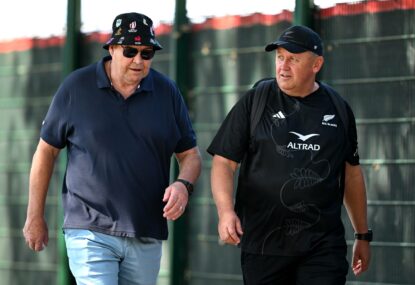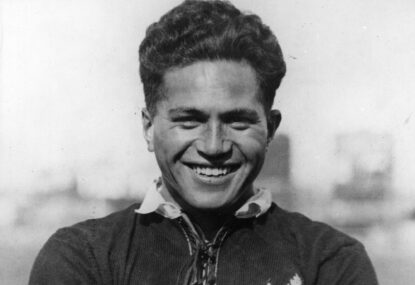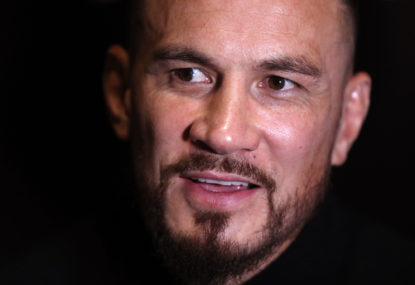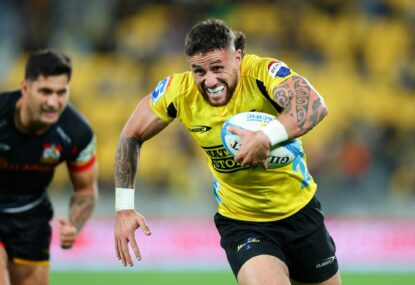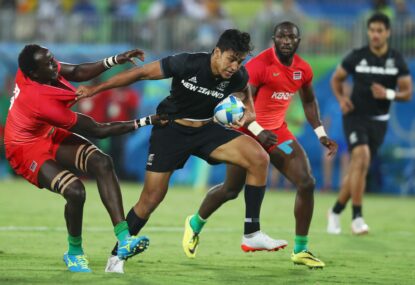New Zealand World Cup winner Steve Hansen was back on familiar ground in Lyon on Monday when he started a brief stint in the All Blacks camp ahead of their second match.
Wearing a bucket hat to protect his head from searing heat, he spent time with Aaaron Smith and other key members of the team.
It’s two weeks since Hansen caused a stir by answering a call from his mate Eddie Jones to help the Wallabies.
“I’ve brushed shoulders with Steve a few times and he’s positive,” Jordie Barrett told reporters on Monday. “He’ll be adding his expertise where he can. I haven’t had a chance to chat to him yet but I’ll take what I can from Steve it’s good to have him back in camp.”
Hansen spent time with Ian Foster and his assistant Jason Ryan.
“On a personal level he’s been unbelievable for me right through my Super Rugby career and into the All Blacks,”said Ryan. “He’s someone I stay in contact with all the time. He’s got a beautiful eye on him. He drops a few good one-liners in but he also helps the coaches and wants the All Blacks to be better first and foremost so it’s been good.
“He’s the greatest coach we’ve ever had so it’s really special to have him in here.”

Steve Hansen walks with head coach Ian Foster of the All Blacks following a New Zealand All Blacks training session. (Photo by Hannah Peters/Getty Images)
Barrett meanwhile said he was pushing to be fit for the second pool match against Namibia this weekend having missed the loss to France with a knee injury.
“It’s coming along pretty good. I had a slow 10 to 14 days but it’s on the improve,” Barrett said.
“It came on out of nowhere in the last couple of weeks. It’s a joint injury with a bit of inflammation but I’m getting there, making progress each day. I got back out on the park today which is positive.
“You want to play every test and be available all the time but it’s not all doom and gloom it’s a long tournament and our team is in a good spot this week so I’m happy to be back out training.”
All Blacks skipper Sam Cane remains doubtful after suffering back spasms the day before the opener. He was badly missed in the France loss.
“He didn’t train today, he got through a little bit of running work and we’ll reassess him tomorrow,” Ryan told reporters in Lyon on Monday.
“We’ve got to get him right, and now’s the chance to do that. We won’t be taking any risks with the skip because he’s important to us.”
Boks giant facing fitness battle
Springboks lock Eben Etzebeth will likely be out for 10 days with a shoulder injury, making him doubtful for the big Pool B game against top-ranked Ireland.
Etzebeth went off in the first half of South Africa’s 18-3 win over Scotland on Sunday and Erasmus said he would go for scans.
“We might find out it’s much more serious, but at this stage it looks like a 10-day injury,” South Africa director of rugby Rassie Erasmus said on Monday.
Etzebeth is the most experienced player in the South Africa squad with more than 100 Test caps, and is a pivotal figure in the forward pack.
On the time frame Erasmus talked of, the key second rower would be ready again around three days before the highly-anticipated match between the defending champion Springboks and world No.1 outfit Ireland on September 23.
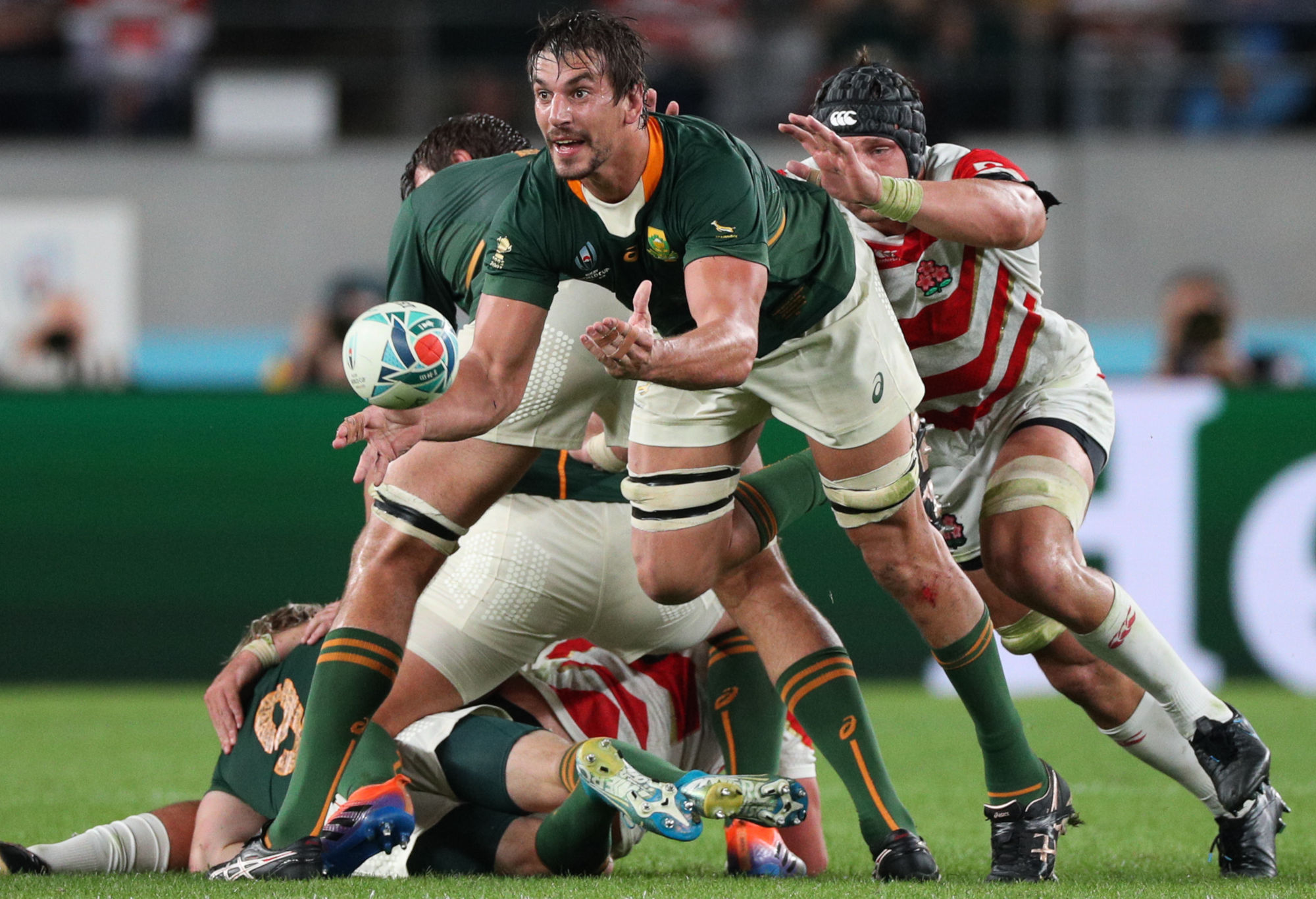
Eben Etzebeth of South Africa (Photo by Craig Mercer/MB Media/Getty Images)
But that doesn’t guarantee Etzebeth will be able to play, Erasmus said, given that he may miss some training in the week before the game.
“We’ll have to make the right call because we can’t have players who are 70 or 80 per cent,” Erasmus said.
Etzebeth did not appear to be in too much discomfort and watched the rest of the Scotland game from the bench, and even joined in on a lap of honour afterwards.
The winner of the match between the world’s top two will also likely avoid playing hosts, on-form France, in the quarterfinals, although that would only mean a probable last-eight clash with three-time champions New Zealand instead.
It appears centre Jesse Kriel has escaped a citing for a a tackle that led to a head clash with Jack Dempsey.
Erasmus said he thought that Kriel first made contact with the ball being carried by Scotland No.8, the former Wallaby Jack Dempsey, and “we’re very happy with how it was refereed.”
“I’m pretty sure there won’t be a citing,” Erasmus said.
“There definitely wasn’t head-on-head contact, it was a tackle on the ball. He moved up after making the tackle on the ball.
“I’ve seen a few stills where that were taken just after Jesse made direct contact on the ball. You can make any tackle like that look really bad. If you look a millisecond or a second or two back, you will see that he clearly tackled on the ball.
“So, yeah, we are very happy with how it was refereed. We are happy with the decision that was made. I will be very surprised that, with first contact on the ball, there will be anything from that.”
Scotland coach Gregor Townsend saw the hit in the game’s opening minutes differently and said he had expected it to be examined by television match officials.
Referee Angus Gardner, of Australia, and the TV officials took no action and allowed play to go on.
The lack of action was described by former Scotland captain John Barclay as “bizarre”.
“The confusion is you hear captains speak to the referees and they say, ‘We are always looking’. You are two minutes into the game and we’ve got an incident that is a red card. It’s a red card.
“He comes from a distance, clear line of sight, no drop in height and he applies force. It’s head on head. That’s a red card. The way the game is refereed now, whether you like it or not, that is a red card. And we saw a very similar incident last night (with Tom Curry) which was given as a yellow then upgraded in the bunker to a red.
“This is where the game gets a bit messy as in these instances where they look very similar, yeah from slightly different positions from a kick or whatever, but that’s a red card. And the fact that has not even been seen or reviewed is inexcusable.”
Meanwhile Erasmus has defended the team’s use of a lighting system to relay messages to the players from the coaches’ box.
South African media reported Erasmus famously used similar tactics during his days as head coach of the Free State Cheetahs over a decade ago.
Erasmus used coloured cards and lights to communicate with his players.
“In terms of the lights, it started when we played the French in Marseille last year. With this dome, the sound is phenomenal, you can’t hear people,” Erasmus told reporters.
“Because there are lots of channels during the match where we communicate, it’s difficult in that atmosphere to talk to our support staff. A lot of teams will have a system to certain aspects, like, for example, how serious is the injury? Is it just a knock? That type of communication.”
“It’s like using hand signals. You don’t need permission from World Rugby. I was still at Munster when we employed a similar system,” said Nienaber.
“The light would be red if it’s a serious thing and one must consider a substitution. Amber tells the support staff to give a guy another five or ten minutes to see if he’s okay. Green obviously means go-on. We did it in Ireland in 2016-17 too.
“It’s an easy way of communicating instructions because, with the stadium noise, the radio channels can get consumed by medical talk. We really just use it for injuries or substitutions.
“There’s nothing tactical or technical about it.”
McReight: ‘I’m not a rock star’
Fraser McReight has laughed off a description by Wallabies coach Eddie Jones that the openside flankers are the “rock stars” of a rugby team.
While his blond locks give off Kurt Cobain vibes, the 24-year-old insisted he wasn’t seeking the spotlight within the Wallabies’ World Cup campaign in France.
McReight is following a golden path of players to wear the Wallabies No.7 jersey, most recently Michael Hooper, the country’s most capped captain.
Before Hooper, who was left out of the World Cup squad, there was the likes of flankers David Pocock, George Smith, David Wilson and Simon Poidevin who carried some swagger within the Wallabies.
Further afield, legends like All Black Richie McCaw and Springbok Francois Pienaar captured the headlines.
McReight laughed when told of Jones’s characterisation and thought it could have been the coach playing some mind-games.
“I think he’s pretty good at keeping people level and keeping them grounded but then he knows the right time of when to pump people’s tyres up really well and that’s the experience he has, being around for so long,” said McReight, who has played 14 Tests since making his debut in 2020.
“I’m probably not the only person getting it; everyone in the group is getting it at different times.
“I definitely wouldn’t say I’m a rock star – I’m far from it – I’ll stay away from that!”
McReight represents the changing of the guard under Jones, taking over from Hooper, who played 125 Tests and led the team for the best part of the last decade.
In Australia’s opening pool game win over Georgia in Paris, the Queenslander did his best to emulate Hooper’s indefatigable approach.
He topped the tackle count, making 11 from his 80 minutes at Stade de France, which was three more than the next best Wallaby, Tom Hooper.

(Photo by Chris Hyde/Getty Images)
With an average age of 23, McReight said six backrowers in the squad had formed a tight bond off the field.
“There’s times where we meet as a group and have a coffee and chat about the game and how we’re feeling and how we can add to the group and I think that’s really important,” he said.
“We’re all very young and have played a lot of footy together so we get along really well.
“It’s about coming together really well and connecting because there’s going to be players who aren’t picked.
“The calibre of our backrow group is quite high so it’s about training really hard together and pushing each other to get better and then once we step off the field we’re mates again.”
(With agencies)





























































































